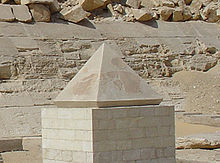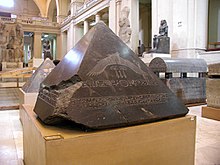Pyramidione





As Pyramidion in which is archeology the equally pyramidal uppermost, last or keystone of a pyramid called - in the Ancient Egyptian benbenet as mentioned above with the so-called Benben associated - and also the pyramidal tip of a obelisk . Pyramidia of pyramid structures have almost the same proportions as these and represent them as a reduced or compressed form. In the Old Kingdom this form was carved out of a block of diorite , granite or limestone . Often the side faces are inscribed and coated with electrons .
Finds
Not many of the pyramid tips of Egyptian pyramids have yet been found. In the case of some of the finds, also because of their state of preservation, it is not certain whether they actually arose at the top of a pyramid and, if so, which one. Some could also have belonged to an obelisk.
The earliest ones come from the Old Kingdom , the limestone fragments of the approximately one and a half meter high pyramidion (see figure above) , which is now in a restored form in front of the Red Pyramid of Sneferu in Dahshur , are the oldest and date back to before 2620 BC. Dated. Also belonging to the 4th dynasty is the pyramidion of the cult pyramid (G Id) of Chufu at the southeast corner of the Great Pyramid , and also the square base of a pyramidion of a secondary pyramid (G III-a) of the Menkaure south of the Mykerinos pyramid , both in Giza and made of limestone. The 5th Dynasty assign a Pyramidionfragment the Chentkaus-II. pyramid made of dark granite, which had a metal coating, and one near the Lepsius XXIV pyramid , both in Abusir . Several pyramidia are known for the 6th dynasty , four from the complex of the Teti pyramid in Saqqara , two of them with a rectangular base and each almost half a meter high.
Fragments of pyramidia made of red granite near two queen tombs of the Sesostris I pyramid complex in El-Lischt , inscribed fragments of the pyramidion of the Sesostris II pyramid in El-Lahun and that are preserved from the Middle Kingdom and assigned to the 12th dynasty all-round inscriptions made of black granite of the pyramid of Amenemhet III. in Dahshur (see picture below).
Two unlabeled pyramidia made of black granite date to the Second Intermediate Period , both at the entrance of a tomb building (the South Pyramid ), also in South Saqqara, and several fragments of the inscribed pyramidion from the pyramid of Chendjer , also according to its inscription, from black granite of the (so far not localized) tomb of Aja I. , all from the 13th dynasty , next to them from the 17th dynasty that of the mud brick pyramid of Nub-cheper-Re Anjotef in Dra Abu el-Naga .
Numerous pyramidia of official graves decorated according to a fixed picture scheme originate from the New Kingdom , the superstructure of which was allowed to be built as a brick pyramid at that time. This also includes the half-meter high pyramidion of Moses or Mes, a scribe of the 19th dynasty at the time of Ramses II . It was made of limestone and is now in the Hildesheim Roemer and Pelizaeus Museum .
Geometric proportions
The pyramidia found correspond to their shape, idealized, to the geometric body of a straight pyramid based on a square . Some have a rectangular , most a square base; There are differences in the dimensions of the base and the height, or in the size of the base and inclination of the sides. In the case of a regular, straight pyramid on a square base, the angle of inclination α of the four sides of the lateral surface results from the respective ratio of height h to base b (tan α = 2 • h / b). For example, a pyramidion on a square basis with four exactly equilateral triangles as side surfaces - with all 8 edges of the same length - results in an angle of inclination of 54 ° 44 '(rounded; height to base length is the same here ).
Roughly that angle of inclination was made around 2650 BC. . Chr in the Old Kingdom on the first try of the Snefru to let build a large-stepped pyramid, in the second construction phase of the kink pyramid realized on a square of about 190 meters length basis; but because of the technical difficulty of transferring the enormous load of the building in a stable manner, the upper part of the building was then executed in the final third construction phase with a flatter slope, an angle of about 44 °. With this angle of inclination, two kilometers north on a larger area (base dimension about 220 meters) the first non-stepped and unbuckled large pyramid was built, the approximately equally high Red Pyramid of Sneferu on the plateau of Dahshur .
Details of the pyramidion of Amenemhet III.

The pyramidion of the building also called the Black Pyramid , the Pharaoh Amenemhet III. from the 12th dynasty in the Middle Kingdom right at the beginning of his reign and so before 1800 BC. In Dahshur , was found there in 1900 AD in the rubble on the east base. The pyramid-shaped end stone measures about 1.85 m as the base length of the square base and about 1.40 m in height; it is made of black granite and has inscriptions on all sides. It is possible that the stone, like the tips of some obelisks, was coated with electron , a metallic alloy of gold and silver. The smooth surface, which has not been attacked, also suggests that this pyramidion was never placed on top of a pyramid.
Already during the construction work on the Black Pyramid in Dahshur, subsidence and cracks of the structure, which was too heavy for its subsoil , would have become or was the highest pyramid built in the Middle Kingdom with an assumed angle of slope of around 57 ° with a good 80 m. Amenemhet III. soon after this first started the construction of a second, the Hawara pyramid of the same base area (side length about 105 meters), but with a smaller angle of inclination (about 49 °) and at another location, near the Sesostris II pyramid in Fayyum Basin .
literature
- Pyramidione. In: Dieter Arnold : Lexicon of Egyptian architecture. 2nd Edition. Artemis & Winkler, Munich et al. 1997, ISBN 3-7608-1099-3 , pp. 205f.
- Pyramidione. In: The Brockhaus Archeology. High cultures, excavation sites, finds. Brockhaus, Mannheim / Leipzig 2009, ISBN 3-7653-3321-2 , p. 500.
- Nairy Hampikian: How was the Pyramidion Placed at the Top of Khufu Pyramid? In: Heike Guksch, Daniel Polz (Ed.): Stations. Contributions to the cultural history of Egypt. von Zabern, Mainz 1998, ISBN 3-8053-2526-6 , pp. 47-51.
- Peter Jánosi : The pyramidion of the pyramid G III-a. In: Ulrich Luft (Ed.): The Intellectual Heritage of Egypt. Studies presented to László Kákosy by Friends and Collegues on the Occasion of his 60th Birthday (= Studia Aegyptiaca, Vol. 14). Chaire d'Egyptologie, Budapest 1992, ISBN 963-462-542-8 , pp. 301-328.
- Mark Lehner : The Complete Pyramids. Reprinted edition. Thames and Hudson, London 2000, ISBN 0-500-05084-8 .
- K. Martin: Pyramidion. In: Wolfgang Helck , Eberhard Otto (Hrsg.): Lexikon der Ägyptologie. Volume 5: Building a pyramid - stone vessels. Harrassowitz, Wiesbaden 1984, ISBN 3-447-02489-5 , pp. 23-25.
- Rainer Stadelmann : The Egyptian pyramids. From brick construction to the wonder of the world (= cultural history of the ancient world . Vol. 30). 3rd, updated and expanded edition, von Zabern, Mainz 1997, ISBN 3-8053-1142-7 .
Web links
Individual evidence
- ^ Adolf Erman, Hermann Grapow: Dictionary of the Egyptian language. Hinrichs, Berlin, 1959, entry 459.13-14
- ↑ Abeer El-Shahawy (Ed.): The Egyptian Museum in Cairo: a walk through the alleys of Ancient Egypt. Farid Atiya Press, Cairo 2005, ISBN 977-17-2183-6 , p. 123 ( at Google Books ). This information gives an angle of inclination of 56 ° 33 '. Other sources give 1.87 m for the base and 1.31 m for the height, which corresponds to 54 ° 46 ', see for example Dieter Arnold: The pyramid district of King Amenemhet III. In Dahshur: The pyramid. Von Zabern, Mainz 1987, ISBN 3-8053-0608-3 , p. 9 and p. 13 ( at Google Books ).
